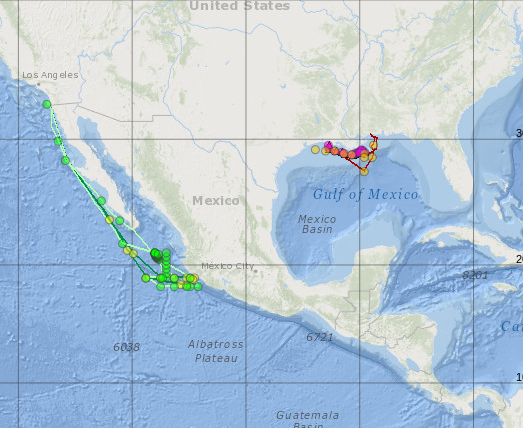 ©2020 Biological and Chemical Oceanography Data Management Office.
©2020 Biological and Chemical Oceanography Data Management Office.Funded by the U.S. National Science Foundation
Oxygen concentration significantly impacts the community structure and function of marine ecosystems. In waters with low oxygen, including the major marine oxygen minimum zones (OMZs), biological diversity is dominated by a complex community of microorganisms whose anaerobic metabolisms mediate key steps in global nitrogen and carbon cycles. Surprisingly, new evidence indicates that OMZs also support diverse microorganisms capable of utilizing inorganic sulfur compounds for energy metabolism. This assemblage appears to include both sulfur-oxidizing autotrophs and sulfate-reducing heterotrophs, suggesting an active sulfur cycle with potentially substantial roles in organic carbon input and mineralization, as well as critical links to the OMZ nitrogen cycle. Our knowledge of the microorganisms driving OMZ sulfur cycling is based largely on the metagenome of a single bacterial lineage (SUP05) and on surveys of diagnostic marker genes, which have thus far targeted only a subset of the diverse low-oxygen regions in the global ocean. The metabolic diversity, activity, and biogeographic distribution of sulfur-metabolizing microorganisms in the OMZ water column remain largely unexplored.
This project uses an integrated molecular and experimental approach to critically examine the physiological and phylogenetic basis of microbial sulfur cycling in oxygen minimum zones. Combining targeted metagenomics with gene expression profiling, microcosm sulfur-addition experiments, and enrichment culturing, the PI will characterize sulfur-metabolizing microorganisms in two oceanographically and ecologically distinct low-oxygen regions: the Eastern Tropical North Pacific (ETNP) OMZ off Mexico, which represents the largest permanent OMZ in the world, and the seasonally hypoxic "dead zone" in the Gulf of Mexico (GOM). Specifically, they will test the hypotheses that sulfur- oxidizing and -reducing bacterioplankton 1) are abundant and transcriptionally active in the ETNP OMZ, 2) are minor components of the hypoxic GOM, but increase in activity and abundance when oxygen decreases and sulfide increases, and 3) exhibit biogeographic variation in functional gene content and phylogenetic diversity over vertical profiles, among OMZs, and in response to environmental gradients.
OMZs are predicted to expand in response to future climate change, making it imperative to holistically understand the biology of low-oxygen regions. This project will establish a comprehensive framework for studying the genomics and physiology of an ecologically important, but poorly characterized, functional group(s) of marine bacterioplankton in OMZs. Results will be analyzed relative to existing metagenomic data from the permanent Eastern Tropical South Pacific (ETSP) OMZ, and a second seasonal OMZ (Saanich Inlet), thereby establishing a comparative basis for describing the ecological distribution of pelagic sulfur-metabolizing microorganisms and their relative role in OMZ community metabolism.

Principal Investigator: Frank James Stewart
Georgia Institute of Technology (GA Tech)
Contact: Frank James Stewart
Georgia Institute of Technology (GA Tech)
DMP_Stewart_OCE-1151698.pdf (71.50 KB)
10/29/2014
Revised DMP, reflects connection of project environmental data to related NCBI accession numbers. (71.63 KB)
10/29/2014